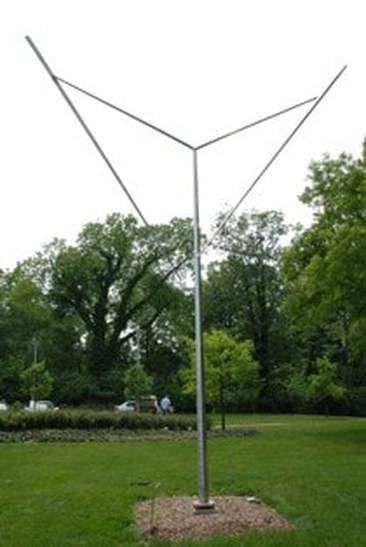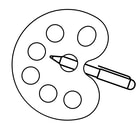|
Mobiles At the entrance to the Dayton Art Museum, a tall piece of kinetic art guards the doors. On second thought perhaps it is knighting the stream of comers and goers: a shining, polished stainless steel structure, a perpendicular mast (a square-sided pole) 20 feet or so tall, which includes its divergence into a large wye's reaching arms, and at each of their tops, a shining sword-like, tapering, five-foot triangular piece of metal that juts out from the point of attachment near its thicker square end and cuts empty space, slicing around independently at the prodding of invisible currents. I can't see the mechanism that holds these rotating blades in place yet allows their movement. Trying to do so, I stand near the sculpture's base craning my neck and farther off gaining some details in the distance but at the same time of course losing others. This crafts-person's trick in achieving balance is obviously beyond my ken. I can imagine the mind and the limbs creating it, though. They're in a well-lit large warehouse-like room playing with materials that became what I see. Balance seems to be at the centre of this art—maybe it's at the centre of all art. If so, how odd. Some of the most unstable people I know are artists of one sort or another. If this observation is true, then maybe practicing an art based on balance appeals to kinetic artists because they find it hard to achieve balance in their own lives. At any rate, I'm thinking now of their act of creating as performance art, like someone on stage entertaining an audience. To get my drift, go to youtube and view the video of Miyoko Shida Rigolo's performance. You'll have a hard time thinking it's not a trick of video razzmatazz. What she does is totally based on balance. She begins by taking what looks like a large goose feather from the bun in her hair and balancing it upon a slightly longer and what looks like a heavier piece of wood or bamboo, though perhaps it's some lighter material. She holds this second piece at its balancing point, then repeats this procedure with increasingly larger pieces of the same material, slowly balancing one after another beneath the one before it, one hand holding the latest balancing point, the other introducing the newer piece of wood. At the end a large mobile of fourteen pieces slowly circle on her balancing hand and finally upon one last erect piece of wood. All the time during composition, at each stage of construction, you can see the wavering nature of the loose balance as well as the entire piece turning. Then she....well, you need to see the quiet climax, the breathtaking beauty in this finished art, which is mobile even throughout its creation. It's another extension of the mobile idea, which I think must have derived from observing natural phenomena. The leaf or flower on a stem waving as a breeze affects it. The piece of tissue that hangs down tempting prey into deadly range of the angler fish's mouth. The glinting water drops spreading out, sprinkling down onto the ground, creating patterns, dripping from ice as it melts from an eave in bright sunlight several hours during the day. A week of the samaras helicoptering, swirling down from maple trees until gone for another year. The shower of pink crabapple blossoms that I've enjoyed, standing under limbs, immersed in a powerfully rich aroma some springs in my backyard. The more constant example is the night show of stars, which hold such permanent positions that humans have recognized and named the relationship of stars to one another for millennia. A close study of the night sky stimulates wonder of course, and part of that concerns a perception of our own infinitesimal existence in the grandeur of the cosmos. But also, the wonder about what holds the continuing relationship of the things we observe up there in place. Science suggests gravitational pulls, magnetic attractions and repulsions, orbital forces beyond my knowledge but clear enough to me to prompt comparisons. They remind me of the wires and hidden human devices that hold the pieces of popular mobiles in a stable relationship while allowing their movements to occur. In this way I end up also thinking about myself. Human beings are held on our own wires and strings, our invisible emotions and thoughts, the DNA patterns that formulate who we are, the inheritances that go back into humanity's prehistoric origins. Are we not to a large extent mobiles ourselves? And all those supposedly stationary things that we assume are landmarks? The human eye can catch only a limited range of motion. We don't see the tree's slow movement, the erosion of a sandstone crag, or witness very well the hummingbird's flapping wings. If a movement is too slow or too fast, we miss it. Perception also depends on the nature of the moving object's substance and colour. Our eyes have help. Scientists have extended our ability to perceive the otherwise invisible, but we don't have to spend thousands for very complicated machine help. More simply, an album of photographs that show how we looked down through the years back to childhood can shock us and prompt nostalgia. Doesn't it also suggest those hidden wires that connect us all? Making any kind of art employs magic. So does the viewers' appreciation of a piece of art. This kind of rapture lasts for the period during which a creation engages us, when we respond emotionally and intellectually to it. So here I am just outside the Art Museum's front doors, a George Rickey mobile, Two Lines Oblique, prodding me to circle around it in my mind, following the artist's impulses, judgments, and skill, levitating in my imagination at the artist's stimulation. Bill Vernon Bill Vernon served in the United States Marine Corps, studied English literature, then taught it. Writing is his therapy, along with exercising outdoors and doing international folk dances. Five Star Mysteries published his novel Old Town, and his poems, stories and nonfiction have appeared in a variety of magazines and anthologies.
0 Comments
Your comment will be posted after it is approved.
Leave a Reply. |
The Ekphrastic Review
COOKIES/PRIVACY
This site uses cookies to deliver your best navigation experience this time and next. Continuing here means you consent to cookies. Thank you. Join us on Facebook:
July 2024
|




